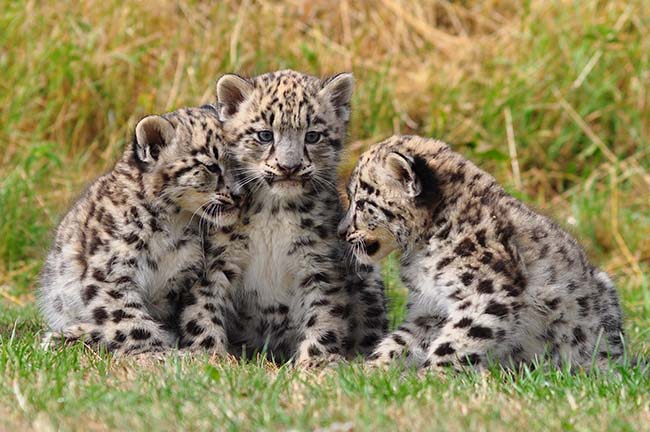Snow leopards are an endangered species of wildlife surviving across the high altitude mountains of the South and Central Asia stretching from the mountains of Central Asia across Afghanistan and Pakistan to the Indian Himalayan belt in the Indian states of Jammu and Kashmir, Uttarakhand, Himachal Pradesh, West Bengal (Darjeeling), Sikkim and Arunachal Pradesh. It is estimated by international wildlife investigating agencies that less than 6,000 wild snow leopards are currently available along with over 500 under various captive breeding programs in several zoological gardens across the world. Hence, captive breeding program for snow leopards is an important conservation effort to protect this majestic but endangered species across South Asia. On this account the snow leopard breeding centre at the Padmaja Naidu Himalayan Zoological Park in the Darjeeling Hills of the Eastern Himalayas of India deserves special mention.
The Padmaja Naidu Himalayan Zoological Park is a jewel in the crown of captive breeding approaches for endangered high altitude Himalayan fauna of India. The state of the art snow leopard breeding centre of international standard and repute at the Padmaja Naidu Himalayan Zoological Park is the only officially recognized snow leopard breeding centre in the entire nation. It has made significant contribution towards the captive breeding of endangered snow leopard population of India as well the entire Central, South and SE Asia. Established in 1958, it has the rare recognition of being the largest high altitude (6900 ft) zoological garden of the nation. The various endangered species successful captive breeding programs at this institute (mammals like Red Panda, Snow Leopard, Tibetan wolf, Himalayan tahr and Blue sheep; birds such as Himalayan monal, Grey peacock pheasant, Blood pheasant, Satyr tragopan and amphibians like the rare Himalayan newt) have received global attention and appreciation.
Currently the park houses one male and nine female snow leopards and recently it has acquired a two year male, named Makalu from UK to boost the captive breeding program with induction of new blood lines following international breeding directives and protocol for endangered snow leopard. Such initiatives are expected to add new dimension to the captive breeding program at the zoo and further contribute towards increasing the endangered snow leopard population of India. The zoo garden is credited to witness the successful births of 40 snow leopard cubs in the past two decades. We expect to see many more accolades added to the zoo in the coming years where it will continue to contribute towards the successful captive breeding of several endangered or critically endangered wildlife species living in the higher altitudes of the Indian subcontinent.
If the breeding center continues to strive good in the near future; this could easily transform into a larger captive breeding centre of snow leopards catering for the entire South Asia including Afghanistan, Pakistan in addition to India. Possibly, snow leopards born in the centre could be also introduced in Afghanistan and Pakistan; as close SAARC members in participatory conservation programs like Joint Conservation Initiative (JCI). Snow leopard populations in Pakistan and Afghanistan are also in a process of steady decline due to both natural causes such as Climate Change and Global warming as well as anthropogenic pressures and hence need active conservation efforts by both Pakistan and Afghanistan governments. Although a marginal increase in snow leopard populations mostly in sparsely populated, vastly inaccessible and uninhabited mountain ranges in Afghanistan and India; Pakistan has been worst hit. Latest census data suggests that less than 200 individuals surviving in the wild in Pakistan. Hence, the snow leopard population in Pakistan can be easily considered as critically endangered.
Species like snow leopards survive at the apex of the food chain in an extremely challenging ecosystem of low temperature, high annual precipitation, difficult mountain terrains often inaccessible for humans with poor prey bases. In spite of the odds and challenges posed by the ecosystems and the habitats in which they survive, the species have evolved, adapted and been successful in occupying the strata of the top predator. Hence it is absolutely important to protect such flagship species; since if this species will survive successfully being at the apex of their ecosystem; all other components if that ecosystem will also be successfully protected.
It will be important for South Asian nations sharing the SAARC platform to extend their cooperation in conservation of the local forests and wildlife through Joint Conservation Initiative (JCI) where adjoining nations support one another through funding, technology and expertise in conserving related species beyond the international boundaries for long term sustenance of the species. It is important to conserve transboundary species like snow leopards across their entire range or habitat and not be restricted to just one specific country or region. If India, Pakistan and Afghanistan could join hands in the conservation of snow leopards through the captive breeding program of Padmaja Naidu Himalayan Zoological Park of Darjeeling in Eastern Himalayas that may bear fruits if success for the future conservation of this majestic high altitude predator. This could transform into a international model of international cooperation and collaboration for initiating similar global conservation efforts between adjacent countries for transboundary species.
Home » Opinion » Captive Breeding of Endangered Snow Leopard
Captive Breeding of Endangered Snow Leopard
| Saikat Kumar Basu

